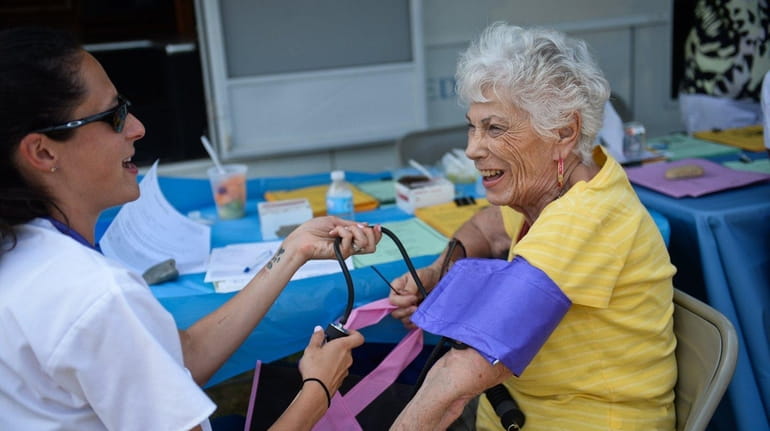Masked hypertension affects millions, LI researchers say

Winthrop nurse Christine Pagano, left, takes the blood pressure of Harriet Morgenstern of Hewlett during a Health Expo held at Eisenhower Park in East Meadow, July 26, 2015. Credit: Steve Pfost
Millions of people who think they have healthy blood pressure because the clinician who measured it found it to be normal may be among the 1 in 8 Americans with so-called masked hypertension, Long Island researchers reported Wednesday.
The condition is so widespread, said Joseph Schwartz, the Stony Brook University medical investigator who led the research, that scores of people have been misclassified as having healthy blood pressure. In reality, he said, these patients have masked hypertension, a term coined by Schwartz and his team. He estimates 17.1 million people nationwide have masked hypertenstion.
“We found that it affects men more than women and that’s possibly because men tend to have higher blood pressure in general,” Schawrtz said, noting that older people and those who are overweight are at elevated risk.
“The one thing that is important to say here is that the higher your blood pressure is in the clinic — even if not high enough to qualify as hypertension — the more likely it is that you will develop this,” he said.
No one, Schwartz said, is immune from masked hypertension.
“I had masked hypertension before I had clinical hypertension,” Schwartz said of having his blood pressure properly taken in a clinical setting, which confirmed that even he had been misclassified as having healthy blood pressure.
Schwartz takes blood pressure-lowering medication to control the disorder, he said.
He and his colleagues unmask hypertension by measuring patients’ blood pressure around the clock, capturing readings over a 24-hour period. This type of measurement is called ambulatory blood pressure monitoring, which uses a device that fits around the upper arm and attaches to a monitoring pack strapped around the waist.
The system automatically measures blood pressure at preset intervals, usually every 15 to 20 minutes.
In research published last month, he and his collaborators at Stony Brook and Columbia University reported the results of ambulatory monitoring for nearly 900 Long Islanders. That analysis debunked the long-held notion of “the white coat effect,” which long suggested that some people have high blood pressure only in a doctor’s office, brought on by the anxiety of a medical examination. Now, he and his colleagues say the white coat effect is a harbinger of hypertension.
His new investigation, published in the American Journal of Epidemiology, assessed participants in the massive National Health and Nutrition Examination Survey, an ongoing government research project that analyzes the health of people throughout the United States.
Using that data, Schwartz imputed the ambulatory blood pressure for 139 million adults over age 21. The result was his new finding — 1 in 8 U.S. adults have masked hypertension.
High blood pressure is a chronic but treatable condition. When untreated, the disorder significantly escalates risks for heart attack, heart failure and stroke. Scientists at the Centers for Disease Control and Prevention estimate 75 million people nationwide have hypertension, a condition frequently called a silent killer.
Dr. Jie Jane Cao, director of Research and Cardiac Imaging at St. Francis Hospital in Flower Hill, said hypertension is sometimes so silent people are unaware they’re affected.
“When it is mild it can be masked for many, many years,” said Cao, who was not involved in the Stony Brook research. “It can be picked up quite incidentally,” she said, referring to a chance physical exam.
Symptoms can vary but may manifest as headache, dizziness, pain in an eye, shortness of breath, or in some cases, chest pain, she said.
“Clinically we make the diagnosis of hypertension based on a systolic blood pressure greater than 140,” she said of the numerator in the measurement fraction. “And, a diastolic pressure greater than 90,” Cao said of the denominator. Schwartz said the key to detecting hypertension during a doctor’s visit is having it taken properly: “That means feet flat on the floor, back supported and not talking,” he said.
“People often say to us, no one has ever taken my blood pressure this way before.”
Gilgo Manorville search ... Southold hotel pause ... Home sales ... What's up on Long Island
Gilgo Manorville search ... Southold hotel pause ... Home sales ... What's up on Long Island

